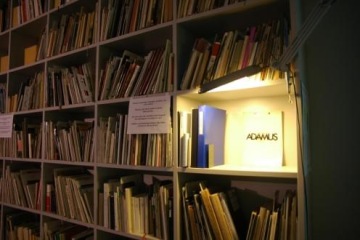At the Archival library at the Center of Contemporary Art
DOX, we have dedicated a space (a shelf) to present artists who work
with books as a unique means of expression. Visitors will be able to view
and leaf through the pages of the exhibited artist's books. A part of the
exhibition will present the documents of authors stored on the abART
system.
Project curators:
Lucie Rohanová, Barbora Špičáková
The
work by Karel Adamus, 10 POEMS PICTURES, inspired by the graphics of Albrecht
Durer finds itself at the border of several genres. It represents the author’s
work, in the form of a volume with ten poems. In the way it reinterprets the
works of others, it relates to the traditions of collage, the ready-made and
appropriation art. In the context of Adamus’ work, we are dealing with an
important realisation exploring the possibilities of visual poetry, which is
probably the most famous author’s cycle of Poem-Pictures. The set was formed in
1971 and the publication of the Kassel Edition Boczkowski was managed by Jiři
Kolář.
Some of the initial works, by Adamus, that occupy the
interface between semantic and visual poetry, date back to the years
of 1967 – 1969. They are still entirely semantic texts, aiming through
the spatial arrangement of language components to emphasize the esthetic
aspects of recording language. The building blocks of semantic poetry are words
and letters, the same as in experimental poetry. The experiment lies in
their non-tradional usage. Nevertheless, the feeling experienced by someone
viewing visual poetry, can be compared to the feelings experienced after
reading semantic poem.
The
initial lettristic Visual poems (from 1969), are followed by The Lyrical
Miniatures (1969 - 1970), in which different types of typewriters appear
for the first time. First of all as hardly noticeable signs (punctuation signs)
and after that as letters. Above all it is the use of typescript, so well liked
by many writers of visual poetry, which Adamus transforms into a distinctive
tool of nonverbal and yet still written – expression.
In the poems created with the use of a typewriter – a
magical tool, which provides all signs with the same space, so that the paper
placed within it, rests under some invisible, yet precise and calculable grid –
where the importance is given not to the word, but to the sign. The sign freed
from mediating concepts, becomes an esthetic unit. Something that is initially
a purely functional script of the typewriter is made anew into an esthetic
form. Fixed signs are displayed on the surface of the paper, independent of the
semantics, the grammar, the typescript; placing emphasis more on the non –
verbal, esthetic components of the work.
In contrast to classical authors such as Josef Hiršal and
Bohumila Grögerová, Adamus is not concerned here primarily with making the word
independent, liberating it from the burden of political misuse, rather he aims
at the mediation of the experience of poetry in another way. He neither moves
towards a more speculative manner of work as expressed by The Theory of texts,
by Max Bense ; but emphatically develops a visual esthetic and the lyrical
qualities of typescript. He brings the initial, general idea into a final,
definitive form , usually in one flash of inspiration, “in one go”. He
holds the view that a plan which is too precise can be harmful to the outcome.
When Adamus first began involving the typewriter in the
creative process, he worked with Durer’s graphics, the dialogue of classical
artworks and the optical and rhythmical characteristics of the machine; the new
unity – powerful impulse towards independent treatment of the entire surface
of the paper, in order to create its own structure.
